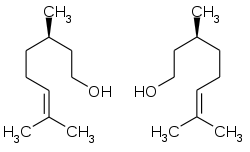Citronellol
 (+)-Citronellol (left) and (−)-citronellol (right) | |
-Citronellol_3D_ball.png) (+)-Citronellol | |
-Citronellol_3D_ball.png) (-)-Citronellol | |
| Names | |
|---|---|
| IUPAC name
3,7-Dimethyloct-6-en-1-ol | |
| Other names
(±)-β-Citronellol; 3,7-Dimethyl-6-octen-1-ol | |
| Identifiers | |
| 106-22-9 | |
| 3D model (Jmol) | Interactive image Interactive image |
| ChEBI | CHEBI:50462 |
| ChEMBL | ChEMBL395827 |
| ChemSpider | 13850135 |
| ECHA InfoCard | 100.012.955 |
| KEGG | C09849 |
| UNII | P01OUT964K |
| |
| |
| Properties | |
| C10H20O | |
| Molar mass | 156.27 g·mol−1 |
| Density | 0.855 g/cm3 |
| Boiling point | 225 °C (437 °F; 498 K) |
| Hazards | |
| NFPA 704 | |
| Except where otherwise noted, data are given for materials in their standard state (at 25 °C [77 °F], 100 kPa). | |
| | |
| Infobox references | |
Citronellol, or dihydrogeraniol, is a natural acyclic monoterpenoid. Both enantiomers occur in nature. (+)-Citronellol, which is found in citronella oils, including Cymbopogon nardus (50%), is the more common isomer. (−)-Citronellol is found in the oils of rose (18–55%) and Pelargonium geraniums.[1]
Preparation
Citronellol can be prepared by hydrogenation of geraniol or nerol.[2][3]
Uses
Citronellol is used in perfumes and insect repellents,[4] and as a mite attractant.[5] Citronellol is a good mosquito repellent at short distances, but protection greatly lessens when the subject is slightly further from the source.[6] When complexed with β-cyclodextrin, it has on average a 1.5 hour protection duration against mosquitoes.[7]
Citronellol is used as a raw material for the production of rose oxide.[8]
Health and safety
The United States FDA considers citronellol as generally recognized as safe (GRAS) for food use.[5] Citronellol is subject to restrictions on its use in perfumery,[9] as some people may become sensitised to it, but the degree to which citronellol can cause an allergic reaction in humans is disputed.[10][11]
See also
References
- ↑ Lawless, J. The Illustrated Encyclopedia of Essential Oils. ISBN 1-85230-661-0.
- ↑ Robert H. Morris (2007). "Ruthenium and Osmium". In J. G. de Vries and C. J. Elsevier. The Handbook of Homogeneous Hydrogenation. Weinheim: WILEY-VCH. ISBN 978-3-527-31161-3.
- ↑ Ait Ali, M; Allaoud, S; Karim, A; Roucoux, A; Mortreux, A (1995). "Catalytic Synthesis of (R) and (S) citronellol by homogeneous hydrogenation over amidophosphinephosphinite and diaminodiphosphine rhodium complexes". Tetrahedron: Asymmetry. 6 (2): 369. doi:10.1016/0957-4166(95)00015-H.
- ↑ Taylor WG, Schreck CE. (1985). "Chiral-phase capillary gas chromatography and mosquito repellent activity of some oxazolidine derivatives of (+)- and (−)-citronellol". J Pharm Sci. 74 (5): 534–539. doi:10.1002/jps.2600740508. PMID 2862274.
- 1 2 "Redirect". epa.gov. Retrieved 29 July 2015.
- ↑ Revay, Edita E.; Kline, Daniel L.; Xue, Rui-De; Qualls, Whitney A.; Bernier, Ulrich R.; Kravchenko, Vasiliy D.; Ghattas, Nina; Pstygo, Irina; Müller, Günter C. (2013). "Reduction of mosquito biting-pressure: Spatial repellents or mosquito traps? A field comparison of seven commercially available products in Israel". Acta Tropica. 127 (1): 63–8. doi:10.1016/j.actatropica.2013.03.011. PMID 23545129.
- ↑ Songkro, Sarunyoo; Hayook, Narissara; Jaisawang, Jittarat; Maneenuan, Duangkhae; Chuchome, Thitima; Kaewnopparat, Nattha (2011). "Investigation of inclusion complexes of citronella oil, citronellal and citronellol with β-cyclodextrin for mosquito repellent". Journal of Inclusion Phenomena and Macrocyclic Chemistry. 72 (3–4): 339. doi:10.1007/s10847-011-9985-7.
- ↑ ""Dark" Singlet Oxygenation of β-Citronellol: A Key Step in the Manufacture of Rose Oxide". Organic Process Research & Development.
- ↑ http://www.ifraorg.org/en-us/standards_restricted/s3/p3
- ↑ Cropwatch Report April 2008
- ↑ Survey and health assessment of chemical substances in massage oils
